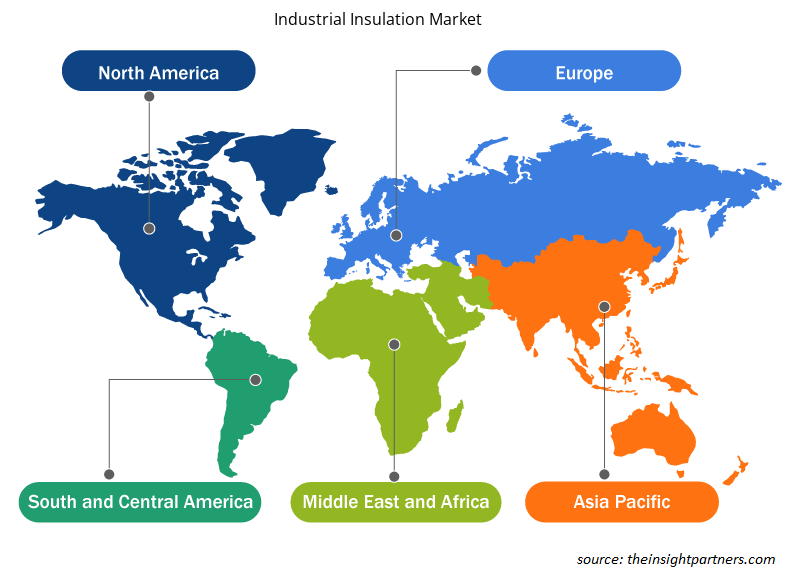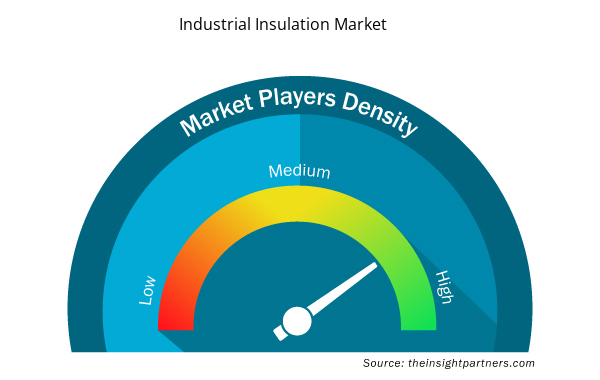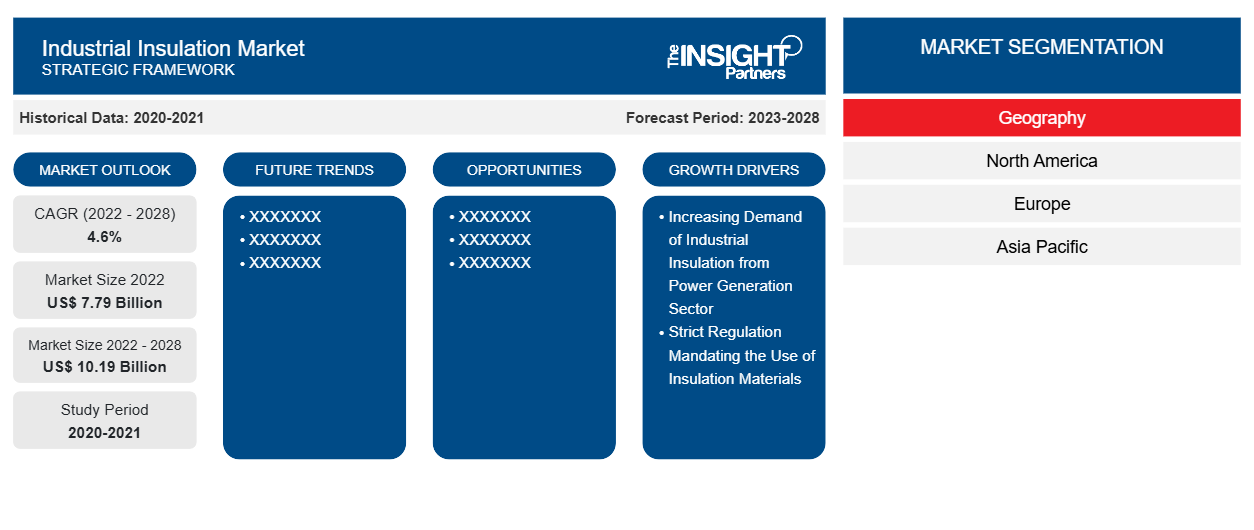[研究报告]工业绝缘市场预计将从2022年的77.9391亿美元增长到2028年的101.8911亿美元;预计2022年至2028年的复合年增长率为4.6%。
市场分析
工业隔热材料在发电、化工和石化、水泥、食品和饮料等各个行业中发挥着重要作用。工业隔热材料在各种水力发电厂中非常重要,因为它有助于蒸汽锅炉保持温度水平。此外,新兴经济体基础设施支出的增加预计将在预测期内为市场增长提供丰厚的机会。随着全球各国建筑活动的增加,对工业隔热材料的需求也在增加。在基础设施中使用工业隔热材料有助于防止高温、火灾和腐蚀。
增长动力与挑战
全球范围内强制使用绝缘材料节约能源的严格规定促进了工业绝缘材料市场的增长。绝缘材料可以抵抗热流,还有助于降低加热和冷却成本。强制使用绝缘材料节约能源的严格规定是推动工业绝缘材料市场增长的主要因素。节能法规和石油和天然气、化工和石化、食品和饮料等终端行业对绝缘材料的需求正在推动市场增长。美国机械工程师学会 ( ASME )、美国锅炉制造商协会 ( ABMA ) 和美国材料与试验协会 ( ASTM ) 等各种协会制定的标准适用于行业设备设计,以实施安全协议,从而促进了工业绝缘材料市场的增长。工业绝缘材料安装成本高对工业绝缘材料市场构成了挑战。工业绝缘材料的安装成本可能因类型、设计、尺寸和复杂程度而异。工业绝缘材料的安装是一个复杂的过程,需要先进的工具和操作。此外,还需要经过技术培训的人员来评估设施规模、隔热面积和隔热材料。此外,安装矿棉、泡沫板和玻璃纤维等重型隔热材料需要合格的专业人员,从而增加了工业安装成本。
定制此报告以满足您的需求
您可以免费定制任何报告,包括本报告的部分内容、国家级分析、Excel 数据包,以及为初创企业和大学提供优惠和折扣
- 获取此报告的关键市场趋势。这个免费样品将包括数据分析,从市场趋势到估计和预测。
报告分类和范围
“2030 年全球工业绝缘市场分析”是一项专业而深入的研究,主要关注全球市场趋势和增长机会。该报告旨在概述全球市场,并按原材料、产品、最终用户和地理位置对市场进行详细细分。全球工业绝缘市场近年来一直保持高增长,预计在预测期内将继续保持这一趋势。该报告提供了全球工业绝缘消费的关键统计数据以及主要地区和国家的需求。此外,该报告还对影响主要地区和国家工业绝缘市场表现的各种因素进行了定性评估。该报告还包括对工业绝缘市场主要参与者及其关键战略发展的全面分析。还包括对市场动态的几项分析,以帮助确定关键驱动因素、市场趋势和有利可图的机会,进而有助于确定主要收入来源。
此外,生态系统分析和波特五力分析提供了全球工业绝缘市场的360度视角,有助于了解整个供应链和影响市场增长的各种因素。
节段分析
全球工业绝缘市场根据原材料、产品和最终用户进行细分。根据原材料,工业绝缘市场细分为羊毛、泡沫、纤维和其他。根据产品,市场分为管道、板材、毯子和其他。工业绝缘市场根据最终用户分为发电、化工和石化、水泥、食品和饮料和其他。根据原材料,泡沫原材料占了很大份额。玻璃纤维形式的羊毛绝缘材料是通过在高温下加热玻璃直至其熔化,然后将熔融的玻璃快速扭曲以形成纤维而制成的。然后将玻璃棉纤维捆绑在一起用作绝缘材料。由于空气是热的不良导体,玻璃纤维会形成气穴,从而起到阻止热量损失的作用。泡沫绝缘材料是一种聚合物产品,广泛用于各种防护和绝缘最终用户,包括隔热、隔音和防风雨。纤维包括天然和合成或塑料纤维。陶瓷纤维和再生塑料瓶(由 PET 制成)主要用于工业绝缘终端用户,形成的纤维被压制成棉絮绝缘材料。根据产品,管道部分占主要份额。由于成本较低且易于安装,玻璃纤维被广泛用于商业、工业和机构建筑中的铁、铜和 PVC 管道的绝缘。工业绝缘板通常用于空心墙的绝缘。毯式绝缘产品主要用于高温装置,工作温度高达 1150°C。毯式绝缘的典型终端用户包括热交换器、烟囱装置、冷却塔、空调管道、大直径管道和储罐。其他产品包括喷涂泡沫绝缘材料和绝缘混凝土。喷涂泡沫绝缘材料是一种空气屏障和绝缘材料,可密封地板、墙壁和天花板空腔以防止空气流动。发电是工业绝缘的主要市场。适当的设备绝缘有助于发电厂的维护,从而降低工人受伤或烧伤的风险。化学加工需要稳定的温度来保持生产质量的一致性和可靠性。预计化学和石化行业的增长将推动对工业绝缘产品的需求。水泥制造是一个连续过程行业,需要先进的热解决方案来优化其产量。其他行业进一步细分为汽车、航空航天、玻璃生产等。工业绝缘解决方案用于帮助保护车辆部件及其电线。
区域分析
报告详细介绍了全球工业绝缘市场,涉及五个主要区域,即北美、欧洲、亚太地区 (APAC)、中东和非洲 (MEA) 以及南美和中美。亚太地区占据了相当大的市场份额,2022 年的价值超过 40 亿美元。预计亚太地区大多数国家的电力需求将继续增长,因此预计在预测期内将推动该地区对工业绝缘产品的需求。北美预计也将出现可观的增长,到 2028 年价值约为 16 亿美元,这归因于终端使用行业越来越多地采用扩张战略,这些行业需要木质素磺酸盐基混凝土外加剂来满足建筑行业对无腐蚀性减水剂日益增长的需求。欧洲的增长速度很快,复合年增长率超过 4.0%。各国化学制造基地和航空航天工业的强大存在支撑了欧洲工业绝缘市场。
行业发展和未来机遇
该报告详细概述了全球工业绝缘市场,涉及五大主要区域,即北美、欧洲、亚太地区 (APAC)、中东和非洲 (MEA) 以及南美和中美。
2022年,圣戈班计划在法国投资1.2亿欧元建设新的玻璃棉生产能力。该投资旨在提高法国的绝缘生产能力。它包括增加现有ISOVER生产线的产量并创建新生产线。
2020 年,Johns Manville 宣布推出面向工业保温市场的全套防水矿棉产品。该产品的推出旨在满足工业保温市场对防水材料日益增长的需求。
新冠疫情的影响/地缘政治形势的影响/经济衰退的影响
该报告详细概述了全球工业绝缘材料市场,涉及五个主要地区,即北美、欧洲、亚太地区 (APAC)、中东和非洲 (MEA) 以及南美和中美洲。建筑、化工和石化、食品和饮料等行业一直是工业绝缘材料的主要消费者。2020 年,由于国家和国际边界关闭导致价值链中断,这些行业不得不放慢运营速度。此外,不同国家实施的封锁阻碍了行业在同一年维持库存水平的能力。这场大流行还对化学品和建筑行业造成了严重破坏。人力短缺导致工业绝缘材料生产和分销业务减速。此外,政府限制和其他 COVID-19 预防措施降低了价值链中工业绝缘材料制造商的生产能力。2021 年,随着各国政府宣布放宽社会限制,全球市场开始从 2020 年的损失中恢复过来。此外,世界各地化学和材料行业的生产能力不断扩大,导致 2021 年工业绝缘材料的需求增加。
工业绝缘材料市场区域洞察
Insight Partners 的分析师已详尽解释了预测期内影响工业绝缘材料市场的区域趋势和因素。本节还讨论了北美、欧洲、亚太地区、中东和非洲以及南美和中美洲的工业绝缘材料市场细分和地理位置。

- 获取工业绝缘市场的区域具体数据
工业绝缘市场报告范围
| 报告属性 | 细节 |
|---|---|
| 2022 年市场规模 | 77.9 亿美元 |
| 2028 年市场规模 | 101.9亿美元 |
| 全球复合年增长率(2022 - 2028) | 4.6% |
| 史料 | 2020-2021 |
| 预测期 | 2023-2028 |
| 覆盖地区和国家 | 北美
|
| 市场领导者和主要公司简介 |
|
市场参与者密度:了解其对商业动态的影响
工业绝缘材料市场正在快速增长,这得益于终端用户需求的不断增长,而这些需求又源于消费者偏好的不断变化、技术进步以及对产品优势的认识不断提高等因素。随着需求的增加,企业正在扩大其产品范围,进行创新以满足消费者的需求,并利用新兴趋势,从而进一步推动市场增长。
市场参与者密度是指在特定市场或行业内运营的企业或公司的分布情况。它表明在给定市场空间中,相对于其规模或总市场价值,有多少竞争对手(市场参与者)存在。
在工业绝缘市场运营的主要公司有:
- 日亚化学公司
- 阿斯彭气凝胶公司
- 麦卡利斯特磨坊公司
- 洛科威公司
- 圣戈班公司
免责声明:上面列出的公司没有按照任何特定顺序排列。

- 了解工业绝缘市场的主要参与者概况
竞争格局和主要公司
工业绝缘市场的一些主要参与者包括 Nichias Corporation、Aspen Aerogels Inc、McAllister Mills Inc、Rockwool A/S、Saint Gobain SA、Knauf Insulation、Kingspan Group、Cabot Corporation、Johns Manville 和 Thomas Group 等。
- 历史分析(2 年)、基准年、预测(7 年)及复合年增长率
- PEST 和 SWOT 分析
- 市场规模价值/数量 - 全球、区域、国家
- 行业和竞争格局
- Excel 数据集



Report Coverage
Revenue forecast, Company Analysis, Industry landscape, Growth factors, and Trends

Segment Covered
This text is related
to segments covered.

Regional Scope
North America, Europe, Asia Pacific, Middle East & Africa, South & Central America

Country Scope
This text is related
to country scope.
常见问题
Asia Pacific is estimated to register the fastest CAGR in the global industrial insulation market over the forecast period. This is mainly attributed to an increasing use of industrial insulation materials in different application fields, increasing infrastructural spending, and strong economic growth.
In 2021, Asia Pacific held the largest share of the global industrial insulation market. The industrial insulation market growth in the region is driven by increasing demand from various industries, including power generation, chemical & petrochemical, and food & beverage, the growing industrial activities, and strong economic growth in the region.
The foams segment held the largest share of the global industrial insulation market in 2021. Foam insulations are commonly used for various proofing and insulation applications, including thermal insulation, acoustic insulation, and weatherproofing.
The global industrial insulation market is primarily driven by increasing demand from power generation sector and strict regulation mandating the use of insulation materials for energy conservation.
Major players operating in the global industrial insulation market includes, Nichias Corporation, Aspen Aerogels Inc., McAllister Mills Inc., ROCKWOOL A/S, SAINT GOBAIN S.A., Knauf Insulation, Kingspan Group, CABOT CORPORATION, Johns Manville, and Thomas Group.
The pipe segment held the largest share of the global industrial insulation market in 2021. Pipe insulation helps to reduces energy losses to a great extent, hence reducing the energy cost. Cellular glass, one of the types of materials used in pipe insulation, is used in ductwork, heat transfer fluid systems, chemical processing systems, commercial pipework, storage tanks, and other application areas.
The List of Companies - Industrial Insulation Market
- Nichias Corporation
- Aspen Aerogels Inc.
- McAllister Mills Inc.
- ROCKWOOL A/S
- SAINT GOBAIN S.A.
- Knauf Insulation
- Kingspan Group
- CABOT CORPORATION
- Johns Manville
- Thomas Group
The Insight Partners performs research in 4 major stages: Data Collection & Secondary Research, Primary Research, Data Analysis and Data Triangulation & Final Review.
- Data Collection and Secondary Research:
As a market research and consulting firm operating from a decade, we have published and advised several client across the globe. First step for any study will start with an assessment of currently available data and insights from existing reports. Further, historical and current market information is collected from Investor Presentations, Annual Reports, SEC Filings, etc., and other information related to company’s performance and market positioning are gathered from Paid Databases (Factiva, Hoovers, and Reuters) and various other publications available in public domain.
Several associations trade associates, technical forums, institutes, societies and organization are accessed to gain technical as well as market related insights through their publications such as research papers, blogs and press releases related to the studies are referred to get cues about the market. Further, white papers, journals, magazines, and other news articles published in last 3 years are scrutinized and analyzed to understand the current market trends.
- Primary Research:
The primarily interview analysis comprise of data obtained from industry participants interview and answers to survey questions gathered by in-house primary team.
For primary research, interviews are conducted with industry experts/CEOs/Marketing Managers/VPs/Subject Matter Experts from both demand and supply side to get a 360-degree view of the market. The primary team conducts several interviews based on the complexity of the markets to understand the various market trends and dynamics which makes research more credible and precise.
A typical research interview fulfils the following functions:
- Provides first-hand information on the market size, market trends, growth trends, competitive landscape, and outlook
- Validates and strengthens in-house secondary research findings
- Develops the analysis team’s expertise and market understanding
Primary research involves email interactions and telephone interviews for each market, category, segment, and sub-segment across geographies. The participants who typically take part in such a process include, but are not limited to:
- Industry participants: VPs, business development managers, market intelligence managers and national sales managers
- Outside experts: Valuation experts, research analysts and key opinion leaders specializing in the electronics and semiconductor industry.
Below is the breakup of our primary respondents by company, designation, and region:

Once we receive the confirmation from primary research sources or primary respondents, we finalize the base year market estimation and forecast the data as per the macroeconomic and microeconomic factors assessed during data collection.
- Data Analysis:
Once data is validated through both secondary as well as primary respondents, we finalize the market estimations by hypothesis formulation and factor analysis at regional and country level.
- Macro-Economic Factor Analysis:
We analyse macroeconomic indicators such the gross domestic product (GDP), increase in the demand for goods and services across industries, technological advancement, regional economic growth, governmental policies, the influence of COVID-19, PEST analysis, and other aspects. This analysis aids in setting benchmarks for various nations/regions and approximating market splits. Additionally, the general trend of the aforementioned components aid in determining the market's development possibilities.
- Country Level Data:
Various factors that are especially aligned to the country are taken into account to determine the market size for a certain area and country, including the presence of vendors, such as headquarters and offices, the country's GDP, demand patterns, and industry growth. To comprehend the market dynamics for the nation, a number of growth variables, inhibitors, application areas, and current market trends are researched. The aforementioned elements aid in determining the country's overall market's growth potential.
- Company Profile:
The “Table of Contents” is formulated by listing and analyzing more than 25 - 30 companies operating in the market ecosystem across geographies. However, we profile only 10 companies as a standard practice in our syndicate reports. These 10 companies comprise leading, emerging, and regional players. Nonetheless, our analysis is not restricted to the 10 listed companies, we also analyze other companies present in the market to develop a holistic view and understand the prevailing trends. The “Company Profiles” section in the report covers key facts, business description, products & services, financial information, SWOT analysis, and key developments. The financial information presented is extracted from the annual reports and official documents of the publicly listed companies. Upon collecting the information for the sections of respective companies, we verify them via various primary sources and then compile the data in respective company profiles. The company level information helps us in deriving the base number as well as in forecasting the market size.
- Developing Base Number:
Aggregation of sales statistics (2020-2022) and macro-economic factor, and other secondary and primary research insights are utilized to arrive at base number and related market shares for 2022. The data gaps are identified in this step and relevant market data is analyzed, collected from paid primary interviews or databases. On finalizing the base year market size, forecasts are developed on the basis of macro-economic, industry and market growth factors and company level analysis.
- Data Triangulation and Final Review:
The market findings and base year market size calculations are validated from supply as well as demand side. Demand side validations are based on macro-economic factor analysis and benchmarks for respective regions and countries. In case of supply side validations, revenues of major companies are estimated (in case not available) based on industry benchmark, approximate number of employees, product portfolio, and primary interviews revenues are gathered. Further revenue from target product/service segment is assessed to avoid overshooting of market statistics. In case of heavy deviations between supply and demand side values, all thes steps are repeated to achieve synchronization.
We follow an iterative model, wherein we share our research findings with Subject Matter Experts (SME’s) and Key Opinion Leaders (KOLs) until consensus view of the market is not formulated – this model negates any drastic deviation in the opinions of experts. Only validated and universally acceptable research findings are quoted in our reports.
We have important check points that we use to validate our research findings – which we call – data triangulation, where we validate the information, we generate from secondary sources with primary interviews and then we re-validate with our internal data bases and Subject matter experts. This comprehensive model enables us to deliver high quality, reliable data in shortest possible time.


 获取此报告的免费样本
获取此报告的免费样本